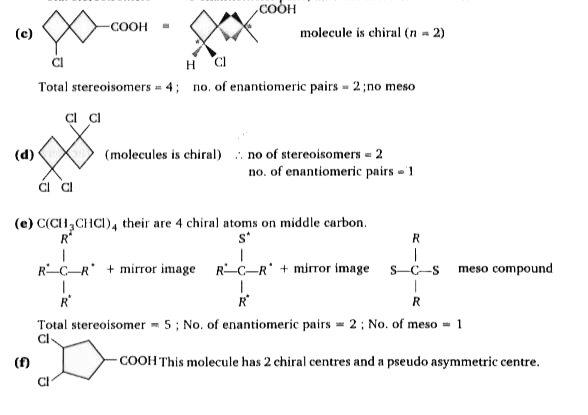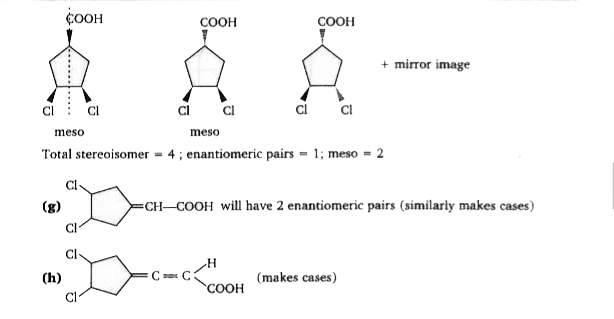The following compounds may exist as two or more stereoisomers. These may be classified as enantiomer pairs or meso compounds.

Answer the following question about the above structure,
(A) Total number of stereoisomers :
(B) Number of enantiomeric pairs :
(C) Number of meso compounds :
The correct Answer is:(a) A-10, B - 4, C-2 (b) A-5, B-0, C-5
(c) A-4, B-2, C-0 (d) A-2, B – 1, C-0
(e) A-5, B-2, C-1 (f) A-4, B-1, C-2
(g) A-4, B-2, C-0 (h) A - 4, B – 1, C-2

Total stereoisomer = 10, Enantiomeric pairs = 4, No. of meso = 2

Total stereoisomers = 5, no enantiomeric pairs, all 5 are meso compounds.


lTotal stereisomer = 4, enantiomeric pairs =1 , meso =2
Topper's Solved these Questions
- ISOMERISM (STRUCTURAL & STEREOISOMERISM)BOOK - MS CHOUHANCHAPTER - ISOMERISM (STRUCTURAL & STEREOISOMERISM)EXERCISE - LEVEL 2 (SUBJECTIVE PROBLEMS)
17 Videos
- ISOMERISM (STRUCTURAL & STEREOISOMERISM)BOOK - MS CHOUHANCHAPTER - ISOMERISM (STRUCTURAL & STEREOISOMERISM)EXERCISE - LEVEL 2 (SUBJECTIVE PROBLEMS)
17 Videos
- HYDROCARBONS (ALKYNES)BOOK - MS CHOUHANCHAPTER - HYDROCARBONS (ALKYNES)EXERCISE - Level -1
32 Videos
- IUPAC NAME BOOK - MS CHOUHANCHAPTER - IUPAC NAME EXERCISE - LEVEL-2 (SUBJECTIVE PROBLEMS )
1 Videos
Similar Questions
The following compounds may exist as two or more stereoisomers. These may be classsified as enantiomer pairs or mest compounds.

Answer the following question about the above structure.
(A) Total number of stereoisomers :
(B) Number of enantiomeric pairs :
(C ) Number of meso compounds :
View SolutionThe following compounds may exist in two or more stereoisomers

(a) Total number of steroisomers. (b) Number of enantiomeric pairs. ( c) Number of meso compounds.
View Solution
Knowledge Check
Which of the following compounds may not exist as enantiomers?
ACH3CH(OH)CO2HBCH3CH2CH(CH3)CH2OHCC6H5CH2CH3DC6H5CHClCH3Which of the following compounds may posses a meso stereosiemer?
ACH3CHCICHBrCHCICH3BCICH2CHBrCH2CICBrCH2CHCICH2CIDCH3CHBrCHCICHCICH3Which of the following compounds may not exist as enantiomers ?
ACH3CH(OH)CO2HBCH3CH2CH(CH3)CH2OHCC6H5CH2CH3DC6H5CHiCH3
Total number of stereoisomers of the compound :-

View SolutionTotal number of stereoisomers of given compound are:

View SolutionTotal number of stereoisomers of given compound are:

View SolutionWhich of the following compounds may not exist as enantiomers?
View SolutionWhich of the following compound has one of the stereoisomers as a meso compound?
View Solution
